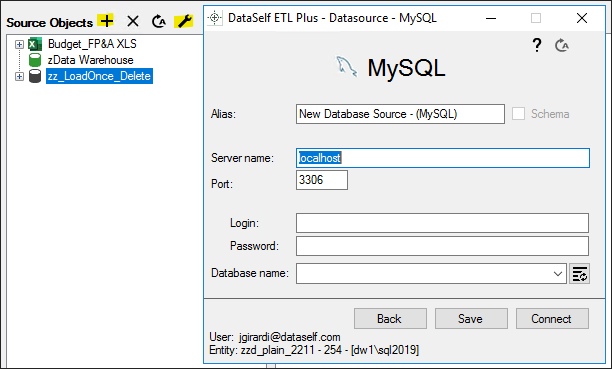ETL+ for MySQL
Installation Checklist
Connecting to MySQL
Connecting to source data stored on a Microsoft SQL Server database.
If you haven’t installed ETL+ yet: ETL+ Deployment Instructions.
Login to ETL+ (help here).
Adding a new MySQL database: On ETL page’s left panel, click
Add Source->MySQL.Maintaining a MySQL source: On ETL page’s left panel, right-click the MySQL source →
Properties.On the
MySQLpage:The
Aliasbox will be automatically populated, but you can customize it.Server name: the MySQL instance name or IP address.Port: the port number.Authentication: select the correct one and its credentials if applicable. Read-only rights required.Database name: The name of the MySQL source database.Click the
Refreshicon on the right to load the list of database names.Use the
dropdown listand select the correct one.
Click
Connect.
You’ll get back to the ETL page and see tables under the new MySQLsource on the left panel.
Mapping and Loading Tables
To view tables available from your MySQL database on the left panel, right-click the MySQL source →
Refresh.To map a MySQL table to the data warehouse,
double-click its nameon the left panel, or right-click on it →Add Table.You’ll now see the table added/mapped to the center panel.
To preview its data, right-click the table on the center panel →
Preview.To load its data to the data warehouse, right-click the table on the center panel →
Load Now.Click the
Logicon (top right) to view data load results. Log page help here.
Schedule the Data Load
On the ETL main page, click
Job(top right icon on the center panel).The Job page usually comes pre-configured to your source system(s).
Overview this page’s configuration. On the right panel, feel free to uncheck tables and Tableau extracts that don’t apply to your reporting needs.
Run a Job now (optional): click the
Run Job(play icon) on the left panel.To schedule the data load (optional):
Select a
Job→Job Properties(wrench icon) → configure the schedule panel →Save
Click
Close->Close.
Testing
After ETL+ has loaded your MySQL tables, this is to check if the data extraction process finished successfully and row count per extracted table matches with your MySQL tables.
Steps
Login to ETL+ (help here).
On the ETL main page, click the top-right
Logicon. Log page help here.Scroll down on the log page and double-check that no table load failed, and the row count matches with the source MySQL tables. Following is an example highlighting two tables from a sample MySQL database and their loaded row count.
